In 2023, Canada experienced its warmest and driest conditions in decades, leading to extreme forest fires that released about 640 million metric tons of carbon. NASA scientists conducted a study using satellite observations and advanced computing to quantify the carbon emissions from these fires, which burned an area roughly the size of North Dakota from May to September. The carbon emissions from these fires were comparable in magnitude to the annual fossil fuel emissions of a large industrialized nation. The study, published in the journal Nature, highlighted the significant impact of these fires on carbon levels in the atmosphere.
The carbon emissions from the Canadian forest fires exceeded the combined emissions from fossil fuels in Russia and Japan in the previous year. While both wildfires and fossil fuel combustion release carbon dioxide (CO2) into the atmosphere, there is an important distinction between the two. The carbon emitted from wildfires can be reabsorbed by Earth’s ecosystems as the forest regrows, whereas CO2 from fossil fuel combustion is not readily offset by natural processes. This distinction underscores the long-term implications of different sources of carbon emissions on the environment.
An ESA instrument called the TROPOspheric Monitoring Instrument (TROPOMI) detected the fire plumes over Canada. TROPOMI, which flies aboard the Sentinel 5P satellite, has the capability to measure trace gases and fine particles in the atmosphere. By measuring the amount of carbon monoxide (CO) in the atmosphere during the fire season, scientists were able to estimate the total carbon emissions from the fires. This technology plays a crucial role in tracking and understanding the impact of wildfires on carbon levels in the atmosphere.
Several factors contributed to the intensity of Canada’s wildfire season in 2023. Climate data revealed that it was the warmest and driest fire season since at least 1980, with temperatures significantly above average and precipitation well below average. These conditions created tinderbox-like conditions across Canada’s forests, leading to widespread fires that charred millions of hectares of land. The increase in wildfires in recent decades can be attributed to extended drought, past fire management strategies, invasive species, and urban encroachment into forested areas.
The unprecedented scale and intensity of the 2023 Canadian forest fires have raised concerns about their impact on global climate. Canada’s forests are important carbon sinks, absorbing more CO2 from the atmosphere than they release. However, if wildfire activity continues to increase, it could potentially offset the carbon uptake by forests, diminishing their capacity to mitigate climate change. Climate models suggest that the conditions experienced in 2023 could become more common in the future, leading to more frequent and severe wildfires that could have far-reaching consequences for the environment.
Canada’s 2023 forest fires were not only a devastating natural disaster but also a significant source of carbon emissions with long-term implications for climate change. The unprecedented scale of these fires serves as a reminder of the urgent need to address the underlying factors contributing to wildfires and their impact on the environment.


Leave a Reply